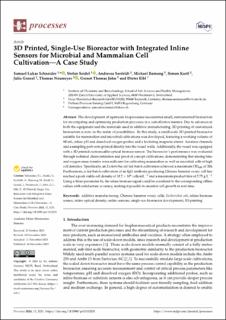Please use this identifier to cite or link to this item:
https://doi.org/10.21256/zhaw-29840Full metadata record
| DC Field | Value | Language |
|---|---|---|
| dc.contributor.author | Schneider, Samuel | - |
| dc.contributor.author | Seidel, Stefan | - |
| dc.contributor.author | Seefeldt, Andressa | - |
| dc.contributor.author | Romang, Michael | - |
| dc.contributor.author | Kastl, Simon | - |
| dc.contributor.author | Gensel, Julia | - |
| dc.contributor.author | Neumeyer, Thomas | - |
| dc.contributor.author | John, Gernot Thomas | - |
| dc.contributor.author | Eibl, Dieter | - |
| dc.date.accessioned | 2024-02-08T14:08:25Z | - |
| dc.date.available | 2024-02-08T14:08:25Z | - |
| dc.date.issued | 2023-11-16 | - |
| dc.identifier.issn | 2227-9717 | de_CH |
| dc.identifier.uri | https://digitalcollection.zhaw.ch/handle/11475/29840 | - |
| dc.description.abstract | The development of upstream bioprocesses necessitates small, instrumented bioreactors for investigating and optimizing production processes in a cost-effective manner. Due to advances in both the equipment and the materials used in additive manufacturing, 3D printing of customized bioreactors is now in the realm of possibilities. In this study, a small-scale 3D printed bioreactor suitable for mammalian and microbial cultivations was developed, featuring a working volume of 90 mL, inline pH and dissolved oxygen probes and a levitating magnetic stirrer. Aeration channels and a sampling port were printed directly into the vessel walls. Additionally, the vessel was equipped with a 3D printed customizable optical biomass-sensor. The bioreactor’s performance was evaluated through technical characterization and proof of concept cultivations, demonstrating that mixing time and oxygen mass transfer were sufficient for cultivating mammalian as well as microbial cells at high cell densities. Specifically, an Escherichia coli fed-batch cultivation achieved a maximum OD600 of 204. Furthermore, a fed-batch cultivation of an IgG antibody-producing Chinese hamster ovary cell line reached a peak viable cell density of 10.2 × 106 cells mL−1 and a maximum product titer of 2.75 g L−1. Using a three-parameter fit, the inline biomass signal could be correlated to the corresponding offline values with satisfactory accuracy, making it possible to monitor cell growth in real-time. | de_CH |
| dc.language.iso | en | de_CH |
| dc.publisher | MDPI | de_CH |
| dc.relation.ispartof | Processes | de_CH |
| dc.rights | http://creativecommons.org/licenses/by/4.0/ | de_CH |
| dc.subject | Additive manufacturing | de_CH |
| dc.subject | Chinese hamster ovary cell | de_CH |
| dc.subject | Escherichia coli | de_CH |
| dc.subject | Inline biomass sensor | de_CH |
| dc.subject | Inline optical density | de_CH |
| dc.subject | Online sensor | de_CH |
| dc.subject | Single-use bioreactor development | de_CH |
| dc.subject | 3D printing | de_CH |
| dc.subject.ddc | 660: Technische Chemie | de_CH |
| dc.subject.ddc | 670: Industrielle und handwerkliche Fertigung | de_CH |
| dc.title | 3D printed, single-use bioreactor with integrated inline sensors for microbial and mammalian cell cultivation : a case study | de_CH |
| dc.type | Beitrag in wissenschaftlicher Zeitschrift | de_CH |
| dcterms.type | Text | de_CH |
| zhaw.departement | Life Sciences und Facility Management | de_CH |
| zhaw.organisationalunit | Institut für Chemie und Biotechnologie (ICBT) | de_CH |
| dc.identifier.doi | 10.3390/pr11113231 | de_CH |
| dc.identifier.doi | 10.21256/zhaw-29840 | - |
| zhaw.funding.eu | No | de_CH |
| zhaw.issue | 11 | de_CH |
| zhaw.originated.zhaw | Yes | de_CH |
| zhaw.pages.start | 3231 | de_CH |
| zhaw.publication.status | publishedVersion | de_CH |
| zhaw.volume | 11 | de_CH |
| zhaw.publication.review | Peer review (Publikation) | de_CH |
| zhaw.webfeed | Verfahrenstechnik | de_CH |
| zhaw.author.additional | No | de_CH |
| zhaw.display.portrait | Yes | de_CH |
| Appears in collections: | Publikationen Life Sciences und Facility Management | |
Files in This Item:
| File | Description | Size | Format | |
|---|---|---|---|---|
| 2023_Schneider-etal_3D-printed-single-use-bioreactor-for-cell-cultivation.pdf | 6.59 MB | Adobe PDF |  View/Open |
Show simple item record
Schneider, S., Seidel, S., Seefeldt, A., Romang, M., Kastl, S., Gensel, J., Neumeyer, T., John, G. T., & Eibl, D. (2023). 3D printed, single-use bioreactor with integrated inline sensors for microbial and mammalian cell cultivation : a case study. Processes, 11(11), 3231. https://doi.org/10.3390/pr11113231
Schneider, S. et al. (2023) ‘3D printed, single-use bioreactor with integrated inline sensors for microbial and mammalian cell cultivation : a case study’, Processes, 11(11), p. 3231. Available at: https://doi.org/10.3390/pr11113231.
S. Schneider et al., “3D printed, single-use bioreactor with integrated inline sensors for microbial and mammalian cell cultivation : a case study,” Processes, vol. 11, no. 11, p. 3231, Nov. 2023, doi: 10.3390/pr11113231.
SCHNEIDER, Samuel, Stefan SEIDEL, Andressa SEEFELDT, Michael ROMANG, Simon KASTL, Julia GENSEL, Thomas NEUMEYER, Gernot Thomas JOHN und Dieter EIBL, 2023. 3D printed, single-use bioreactor with integrated inline sensors for microbial and mammalian cell cultivation : a case study. Processes. 16 November 2023. Bd. 11, Nr. 11, S. 3231. DOI 10.3390/pr11113231
Schneider, Samuel, Stefan Seidel, Andressa Seefeldt, Michael Romang, Simon Kastl, Julia Gensel, Thomas Neumeyer, Gernot Thomas John, and Dieter Eibl. 2023. “3D Printed, Single-Use Bioreactor with Integrated Inline Sensors for Microbial and Mammalian Cell Cultivation : A Case Study.” Processes 11 (11): 3231. https://doi.org/10.3390/pr11113231.
Schneider, Samuel, et al. “3D Printed, Single-Use Bioreactor with Integrated Inline Sensors for Microbial and Mammalian Cell Cultivation : A Case Study.” Processes, vol. 11, no. 11, Nov. 2023, p. 3231, https://doi.org/10.3390/pr11113231.
Items in DSpace are protected by copyright, with all rights reserved, unless otherwise indicated.